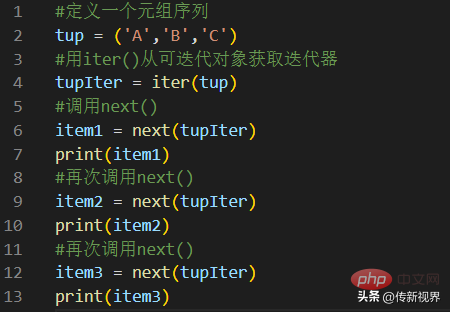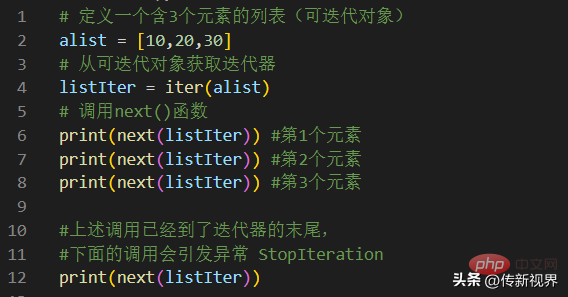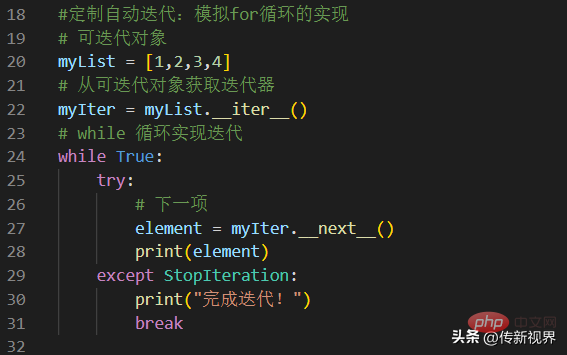 Backend Development
Backend Development
 Python Tutorial
Python Tutorial
 Iterator protocol and traversal methods in Python programming
Iterator protocol and traversal methods in Python programming
Iterator protocol and traversal methods in Python programming
Preface
The introduction of the previous part should make it easy for us to understand and master iterable objects and iterators (Iterable & Iterator) in Python. In this content, we will further introduce the related content of iterators.

1) __iter__(): This method of
object returns the iterator object itself. This is required for containers and iterators to be used with for-in statements. You can also use the built-in iter() function, which essentially calls the __iter__() method behind the scenes.2)__next__():
Return the next item from the iterator. If there are no other items, a StopIteration exception is thrown. You can also use the built-in next() function to read the next item, which is essentially calling the __next__() method. As we said before, lists, tuples, dictionaries and sets are all iterable types. In other words, they are types from which iterators can be obtained. Look at the example:
A B C

P y

| ##10 ##20 30 ##Traceback (most recent call last): ##File ……, in StopIteration In the above code, the next() function is called four times, which is more than the number of items in the iterator. In the last call, a StopIteration exception was thrown - because the elements in the iterator have been iterated. Moreover, in order to ensure that exceptions may be thrown after the manual iteration is completed, exception handling must be performed by yourself, otherwise the subsequent execution will no longer be normal. What needs to be realized is: in most scenarios, we do not need to manually call the next method ourselves. The for loop in Python can automatically traverse any object that can return an iterator. In other words, a for loop can iterate over any iterable object in Python. Please see the example: Code List Snippet 04 In the above code, we use a for loop to traverse the list defined earlier. It is obvious that we did not use the next() function manually and did not get any StopIteration exception. This is the beauty of for loops in Python. It handles all of this for us behind the scenes. Of course, we can handle loop iteration ourselves this way. Now define our own version of the for loop. We will use a while loop and replicate the behavior of a for loop. Here we build everything needed for this implementation ourselves. As shown below: Code Listing Snippet-05 In the above listing, we have implemented our own version of a simulated for loop. An infinite while loop is used in the code: while True. A try-except block is set up inside the loop. In the try block, get the next element by calling the __next__() method on the iterator. If the call is successful, the element is printed. If an error of type StopIteration occurs, the exception is caught in the except block. What you do in the except block is very simple. We just break out of this loop, which means we've reached the end of the iterator. That’s it for this article, which mainly introduces the iterator protocol and iterator traversal. The text of the content is not long, and combined with the code can help you better understand and master these Python programming knowledge points. |
The above is the detailed content of Iterator protocol and traversal methods in Python programming. For more information, please follow other related articles on the PHP Chinese website!

Hot AI Tools

Undresser.AI Undress
AI-powered app for creating realistic nude photos

AI Clothes Remover
Online AI tool for removing clothes from photos.

Undress AI Tool
Undress images for free

Clothoff.io
AI clothes remover

AI Hentai Generator
Generate AI Hentai for free.

Hot Article

Hot Tools

Notepad++7.3.1
Easy-to-use and free code editor

SublimeText3 Chinese version
Chinese version, very easy to use

Zend Studio 13.0.1
Powerful PHP integrated development environment

Dreamweaver CS6
Visual web development tools

SublimeText3 Mac version
God-level code editing software (SublimeText3)

Hot Topics
 1385
1385
 52
52
 PHP and Python: Code Examples and Comparison
Apr 15, 2025 am 12:07 AM
PHP and Python: Code Examples and Comparison
Apr 15, 2025 am 12:07 AM
PHP and Python have their own advantages and disadvantages, and the choice depends on project needs and personal preferences. 1.PHP is suitable for rapid development and maintenance of large-scale web applications. 2. Python dominates the field of data science and machine learning.
 Python vs. JavaScript: Community, Libraries, and Resources
Apr 15, 2025 am 12:16 AM
Python vs. JavaScript: Community, Libraries, and Resources
Apr 15, 2025 am 12:16 AM
Python and JavaScript have their own advantages and disadvantages in terms of community, libraries and resources. 1) The Python community is friendly and suitable for beginners, but the front-end development resources are not as rich as JavaScript. 2) Python is powerful in data science and machine learning libraries, while JavaScript is better in front-end development libraries and frameworks. 3) Both have rich learning resources, but Python is suitable for starting with official documents, while JavaScript is better with MDNWebDocs. The choice should be based on project needs and personal interests.
 Detailed explanation of docker principle
Apr 14, 2025 pm 11:57 PM
Detailed explanation of docker principle
Apr 14, 2025 pm 11:57 PM
Docker uses Linux kernel features to provide an efficient and isolated application running environment. Its working principle is as follows: 1. The mirror is used as a read-only template, which contains everything you need to run the application; 2. The Union File System (UnionFS) stacks multiple file systems, only storing the differences, saving space and speeding up; 3. The daemon manages the mirrors and containers, and the client uses them for interaction; 4. Namespaces and cgroups implement container isolation and resource limitations; 5. Multiple network modes support container interconnection. Only by understanding these core concepts can you better utilize Docker.
 How to run programs in terminal vscode
Apr 15, 2025 pm 06:42 PM
How to run programs in terminal vscode
Apr 15, 2025 pm 06:42 PM
In VS Code, you can run the program in the terminal through the following steps: Prepare the code and open the integrated terminal to ensure that the code directory is consistent with the terminal working directory. Select the run command according to the programming language (such as Python's python your_file_name.py) to check whether it runs successfully and resolve errors. Use the debugger to improve debugging efficiency.
 Python: Automation, Scripting, and Task Management
Apr 16, 2025 am 12:14 AM
Python: Automation, Scripting, and Task Management
Apr 16, 2025 am 12:14 AM
Python excels in automation, scripting, and task management. 1) Automation: File backup is realized through standard libraries such as os and shutil. 2) Script writing: Use the psutil library to monitor system resources. 3) Task management: Use the schedule library to schedule tasks. Python's ease of use and rich library support makes it the preferred tool in these areas.
 What is vscode What is vscode for?
Apr 15, 2025 pm 06:45 PM
What is vscode What is vscode for?
Apr 15, 2025 pm 06:45 PM
VS Code is the full name Visual Studio Code, which is a free and open source cross-platform code editor and development environment developed by Microsoft. It supports a wide range of programming languages and provides syntax highlighting, code automatic completion, code snippets and smart prompts to improve development efficiency. Through a rich extension ecosystem, users can add extensions to specific needs and languages, such as debuggers, code formatting tools, and Git integrations. VS Code also includes an intuitive debugger that helps quickly find and resolve bugs in your code.
 Can vs code run in Windows 8
Apr 15, 2025 pm 07:24 PM
Can vs code run in Windows 8
Apr 15, 2025 pm 07:24 PM
VS Code can run on Windows 8, but the experience may not be great. First make sure the system has been updated to the latest patch, then download the VS Code installation package that matches the system architecture and install it as prompted. After installation, be aware that some extensions may be incompatible with Windows 8 and need to look for alternative extensions or use newer Windows systems in a virtual machine. Install the necessary extensions to check whether they work properly. Although VS Code is feasible on Windows 8, it is recommended to upgrade to a newer Windows system for a better development experience and security.
 Can visual studio code be used in python
Apr 15, 2025 pm 08:18 PM
Can visual studio code be used in python
Apr 15, 2025 pm 08:18 PM
VS Code can be used to write Python and provides many features that make it an ideal tool for developing Python applications. It allows users to: install Python extensions to get functions such as code completion, syntax highlighting, and debugging. Use the debugger to track code step by step, find and fix errors. Integrate Git for version control. Use code formatting tools to maintain code consistency. Use the Linting tool to spot potential problems ahead of time.





